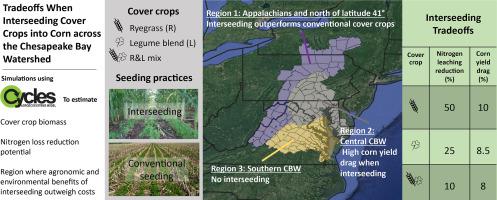Agricultural Systems ( IF 6.6 ) Pub Date : 2023-05-25 , DOI: 10.1016/j.agsy.2023.103684 Curt A. McConnell, Rachel K.N. Rozum, Yuning Shi, Armen R. Kemanian

|
CONTEXT
In annual cropping systems at high latitudes, an early onset of winter limits the establishment of cover crops in fall and ultimately the ecosystem services they provide such as nitrogen (N) leaching reduction. Interseeding cover crops into a standing cash crop can improve establishment before winter, but its practice is limited in both scope and scale.
OBJECTIVE
To identify tradeoffs and establish regional patterns of interseeding success in the environmentally sensitive Chesapeake Bay Watershed of North America, we used the agroecosystem model Cycles to compare in silico systems in which cover crops were either interseeded into a standing crop of corn (Zea mays L.) or conventionally seeded after corn harvest.
METHODS
In each of the 153 counties contained in the Chesapeake Bay Watershed, a representative field was simulated and either seeded with ryegrass (Lolium perenne L.), a blend of legumes, or a mix of legumes and ryegrass in a continuous corn sequence. The simulated corn yield, cover crop biomass production, N leaching reduction, and total N losses were compared between the cover crop scenarios and a monoculture corn control.
RESULTS AND CONCLUSIONS
Simulations showed that conventionally seeded cover crops did not affect corn yields of the following year. However, when interseeded, the drag on corn yield in the same year averaged 6% per Mg of fall cover crop biomass. The corn yield reduction notwithstanding, interseeding reduced N leaching by 10% for legumes, 25% for the mix, and 50% for solo ryegrass compared to the no cover-crop control. There are other tradeoffs, such as an offset of N fertilizer inputs from N2 fixation when using legumes despite the less effective nutrient capture. Regardless of the cover crop type, interseeding up to latitude 41° N tends to be competitive with the cash crop, but north of that threshold (or west into higher elevations) the mitigation of N leaching when interseeding seems to outweigh agronomic costs.
SIGNIFICANCE
This study provides useful insight into watershed-scale agronomic and environmental processes without the constraints of establishing large-scale networks of field trials. Given these analyses, future field research in areas suitable for interseeding can focus on establishing legume cover crops in high-yielding fields with low residual mineral N, grass cover crops in manured or low-yielding fields with residual mineral N, and a mixture of both when N supply is uncertain and preventive management is needed.
中文翻译:

在切萨皮克湾流域将覆盖作物播种到玉米中时的权衡
语境
在高纬度地区的一年生作物系统中,冬季的提前到来限制了秋季覆盖作物的建立,并最终限制了它们提供的生态系统服务,例如减少氮 (N) 淋溶。将覆盖作物与现存经济作物间种可以在冬季前改善植株,但这种做法在范围和规模上都受到限制。
客观的
为了在北美环境敏感的切萨皮克湾流域确定权衡并建立区域间播成功模式,我们使用农业生态系统模型 Cycles 来比较计算机系统,在该系统中,覆盖作物要么被播种到现成的玉米作物中( Zea mays L. ) 或在玉米收获后按常规播种。
方法
在切萨皮克湾流域的 153 个县中的每一个县,都模拟了一个代表性的田地,并在连续的玉米序列中播种黑麦草 ( Lolium perenne L.)、豆类混合物或豆类和黑麦草的混合物。比较了覆盖作物情景和单一栽培玉米对照之间的模拟玉米产量、覆盖作物生物量生产、氮浸出减少和总氮损失。
结果和结论
模拟表明,常规播种的覆盖作物不会影响来年的玉米产量。然而,当间播时,同年对玉米产量的拖累平均为每毫克秋季覆盖作物生物量 6%。尽管玉米减产,但与无覆盖作物对照相比,间种播种可使豆科植物的氮浸出减少 10%,混合作物减少 25%,单独黑麦草减少 50%。还有其他权衡,例如在使用豆科植物时抵消 N 2固定的氮肥输入,尽管其养分捕获效率较低。无论覆盖作物类型如何,在北纬 41° 以内的间种往往与经济作物具有竞争力,但在该阈值以北(或向西进入更高海拔)间种时 N 浸出的缓解似乎超过了农艺成本。
意义
这项研究提供了对流域规模农艺和环境过程的有用见解,而不受建立大规模田间试验网络的限制。鉴于这些分析,未来适合间种的田间研究可侧重于在残留矿物氮含量低的高产田地种植豆类覆盖作物,在残留矿物氮含量高的施肥田或低产田种植草覆盖作物,以及两者的混合当 N 供应不确定且需要预防性管理时。

























 京公网安备 11010802027423号
京公网安备 11010802027423号